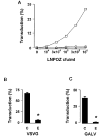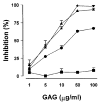Retroviral gene transfer is inhibited by chondroitin sulfate proteoglycans/glycosaminoglycans in malignant pleural effusions
- PMID: 9115227
- PMCID: PMC1626586
- DOI: 10.1074/jbc.272.18.11736
Retroviral gene transfer is inhibited by chondroitin sulfate proteoglycans/glycosaminoglycans in malignant pleural effusions
Abstract
Gene therapy may be an important adjuvant for treating cancer in the pleural space. The initial results of retroviral gene transfer to cancer cells in malignant pleural effusions revealed that transduction was markedly inhibited, and studies to characterize the inhibitory factor(s) were performed. The inhibition was contained within the soluble, rather than cellular, components of the effusions and was demonstrated with amphotropic, gibbon ape leukemia virus, and vesicular stomatitis virus-glycoprotein pseudotyped retroviral vectors. After excluding complement proteins, a series of studies identified chondroitin sulfates (CSs) as the inhibitory substances. First, treatment of the effusions with mammalian hyaluronidase or chondroitinases, but not Streptomyces hyaluronidase, abolished the inhibitory activity. Second, addition of exogenous CS glycosaminoglycans mimicked the inhibition observed with pleural effusions. Third, immunoassays and biochemical analyses of malignant pleural effusion specimens revealed CS in relevant concentrations within pleural fluid. Fourth, proteoglycans/glycosaminoglycans isolated from the effusions inhibited retroviral gene transfer. Analyses of the mechanism of inhibition indicate that the chondroitin sulfates interact with vector in solution rather than at the target cell surface. These results suggest that drainage of the malignant pleural effusion, and perhaps enzymatic pretreatment of the pleural cavity, will be necessary for efficient retroviral vector mediated gene delivery to pleural metastases.
Figures









Similar articles
-
Adenoviral gene transfer is inhibited by soluble factors in malignant pleural effusions.Am J Respir Cell Mol Biol. 2000 May;22(5):613-9. doi: 10.1165/ajrcmb.22.5.3970. Am J Respir Cell Mol Biol. 2000. PMID: 10783134
-
Proteoglycans secreted by packaging cell lines inhibit retrovirus infection.J Virol. 1996 Sep;70(9):6468-73. doi: 10.1128/JVI.70.9.6468-6473.1996. J Virol. 1996. PMID: 8709284 Free PMC article.
-
A general method for the generation of high-titer, pantropic retroviral vectors: highly efficient infection of primary hepatocytes.Proc Natl Acad Sci U S A. 1994 Sep 27;91(20):9564-8. doi: 10.1073/pnas.91.20.9564. Proc Natl Acad Sci U S A. 1994. PMID: 7937806 Free PMC article.
-
Heparan sulfate proteoglycans of Ras-transformed 3T3 or neuroblastoma cells. Differing functions in adhesion on fibronectin.Ann N Y Acad Sci. 1989;556:194-216. doi: 10.1111/j.1749-6632.1989.tb22504.x. Ann N Y Acad Sci. 1989. PMID: 2525358 Review.
-
Generation of high-titer pseudotyped retroviral vectors with very broad host range.Methods Cell Biol. 1994;43 Pt A:99-112. doi: 10.1016/s0091-679x(08)60600-7. Methods Cell Biol. 1994. PMID: 7823872 Review.
Cited by
-
Heparin binds to murine leukemia virus and inhibits Env-independent attachment and infection.J Virol. 2002 Jul;76(14):6909-18. doi: 10.1128/jvi.76.14.6909-6918.2002. J Virol. 2002. PMID: 12072492 Free PMC article.
-
Targeted transgene expression in muller glia of normal and diseased retinas using lentiviral vectors.Invest Ophthalmol Vis Sci. 2007 Apr;48(4):1844-52. doi: 10.1167/iovs.05-1570. Invest Ophthalmol Vis Sci. 2007. PMID: 17389520 Free PMC article.
-
Retrovirus vectors bearing jaagsiekte sheep retrovirus Env transduce human cells by using a new receptor localized to chromosome 3p21.3.J Virol. 2000 May;74(10):4698-704. doi: 10.1128/jvi.74.10.4698-4704.2000. J Virol. 2000. PMID: 10775607 Free PMC article.
-
Cathepsin B Protease Facilitates Chikungunya Virus Envelope Protein-Mediated Infection via Endocytosis or Macropinocytosis.Viruses. 2020 Jul 3;12(7):722. doi: 10.3390/v12070722. Viruses. 2020. PMID: 32635194 Free PMC article.
-
Lentiviral transduction of mammary stem cells for analysis of gene function during development and cancer.Cell Stem Cell. 2008 Jan 10;2(1):90-102. doi: 10.1016/j.stem.2007.10.002. Cell Stem Cell. 2008. PMID: 18371425 Free PMC article.
References
-
- Broaddus, V. C. and Light, R. W. (1994) in Textbook of Respiratory Medicine (Murray, J. F., and Nadel, J. A., eds) pp. 2145–2163, W. B. Saunders Co., Philadelphia, PA
-
- Sahn SA. Clin Chest Med. 1993;14:189–200. - PubMed
-
- Batra RK, Hoganson DK, Olsen JC, Boucher RC. Am J Respir Crit Care Med. 1996;153:A111. (abstr.)
-
- Baumann MH, Strange C, Sahn SA, Kinasewitz GT. Exp Lung Res. 1996;22:101–111. - PubMed
-
- Nakano T, Fujii J, Tamura S, Amuro Y, Nabeshima K, Horai T, Hada T, Higashino K. Cancer. 1986;57:106–110. - PubMed
Publication types
MeSH terms
Substances
Grants and funding
LinkOut - more resources
Full Text Sources
Other Literature Sources
Research Materials
Miscellaneous

